NRAO eNews
October 2009 • Vol. 2, Iss. 10
- Upcoming Events
- ALMA Project Status
- The NAASC Extragalactic Conference on Star Formation and Galaxy Assembly
- Student Observing Support Awards
- New GBT Dynamic Scheduling System
- New High-frequency GBT Operating Benchmark
- Student's GBT Discovery Earns White House Trip
- 2009 Mountain State Award
- Career Opportunities
NRAO eNews: October 2009 • Volume 2, Issue 10

President Barack Obama and First Lady Michelle Obama host an astronomy event on the South Lawn of the White House, October 7, 2009. Participants include: Dr. John Holdren, Office of Science and Technology Policy; Caroline Moore, the youngest person to discover a supernova; and Lucas Bolyard, who recently discovered an anomalous pulsar with the GBT. (Official White House Photo by Chuck Kennedy)
Upcoming Events
 International Year of Astronomy Celebration
International Year of Astronomy Celebration
October 24–25, 2009 | Green Bank, WV
 Jansky Lecture
Jansky Lecture
October 27, 2009 | Charlottesville, VA
January 15, 2010 | Socorro, NM
 Square Kilometre Array PrepSKA Workshop
Square Kilometre Array PrepSKA Workshop
October 29–31, 2009 | Manchester, UK
 Jansky Fellowship Application Deadline
Jansky Fellowship Application Deadline
November 2, 2009
 NRAO Town Hall at the American Astronomical Society Meeting
NRAO Town Hall at the American Astronomical Society Meeting
January 5, 2010 | 6:30 - 8:30 PM | Washington, DC
 New Mexico Symposium
New Mexico Symposium
January 15, 2010 | Socorro, NM
ALMA Project Status
Al Wootten
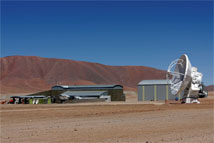
Fig. 1 The first ALMA antenna at the 5050m altitude Llano Chajnantor stands on pad 106. To its left is the Array Operations Site Technical Building that houses the correlator, the central local oscillator, and other equipment beneath the site's spectacularly clear skies. The antenna is controlled entirely from the lower elevation Operations Support Facility, a few dozen kilometers away.
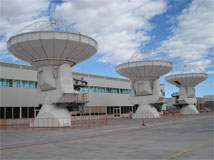
Fig. 2 Three Vertex antennas, including the newly accepted DV03, stand ready for duty in the OSF test area.
On 23 September, the first antenna delivered to the ALMA Assembly Integration and Verification (AIV) continued a long voyage that had begun in Osaka, Japan, traveling on the transporter to become the first antenna to reach the 5050m Array Operations Site (AOS). Within a little over a week, its pointing had been confirmed and observations of astronomical sources had begun with its sensitive receivers. These observations were the first acquired at the AOS, the first astronomical spectra taken with the 64-element correlator, and the first data taken using the central local oscillator. By the end of October, the antenna will be joined by another antenna as preparations for submillimeter interferometry at the site move forward.
The antenna foundation at the OSF, from which the antenna left for the AOS, didn’t stand vacant for long. Soon DV03, the third Vertex antenna, became the fourth antenna to arrive in the AIV team’s hands. At press time, the team at the OSF was performing tests on four ALMA antennas at the two sites. Single antenna tests were under way at the AOS with the newly repositioned antenna and at the OSF with the newly accepted antenna. The two antennas remaining at the OSF continued their interferometric tests. The spot vacated by the newly accepted antenna left an opening for construction of the next antenna. Nine antennas are in various stages of construction at the Vertex Site Erection Facility. Elements of three additional antennas are located at the Alcatel facility, and three Mitsubishi antennas are being readied for acceptance over the coming weeks. The first of the twelve Mitsubishi 7m antennas, to be located in the Atacama Compact Array, has been shipped from Japan and is expected in a few weeks at the OSF.
Joint ALMA Observatory Newsletter, October 2009
The NAASC Extragalactic Conference on Star Formation and Galaxy Assembly
Aaron Evans (NRAO/UVA)
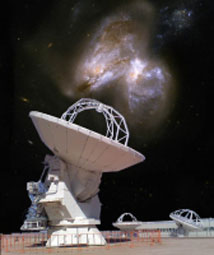
The 4th North American ALMA Science Center (NAASC) conference "Assembly, Gas Content and Star Formation History of Galaxies" was held at the Omni Hotel in Charlottesville, Virginia on September 21 - 24, 2009, under the sponsorship of NRAO, NAASC, the University of the Virginia, AUI, and the NSF. The meeting was praised as a major success by the participants, largely due to the breadth of the science program, the participation of a large number of early career researchers, and the seamless way in which the conference was organized and run by the LOC and IT support.
Approximately 170 astronomers attended, making this the largest NAASC science conference to date. The attendees included over 60 graduate students and postdoctoral scholars, and the majority of the participants were not traditional radio astronomers. As a result, the presentations covered observations and theoretical modeling across a wide range of the electromagnetic spectrum.
The meeting began with a discussion of fundamental issues related to star formation, with a general overview of star formation, the initial mass function of stars, star formation laws and diagnostics. This section was followed by presentations focusing on the gas content and star formation in nearby normal galaxies, nearby and cosmologically distant starburst galaxies and galaxies known to harbor AGN. A significant number of talks covered galaxy evolution through massive mergers and accretion, the effects of environment on galaxy evolution, and the effects of stellar and AGN feedback on ongoing star formation within galaxies.
The science talks were complemented by presentations of upcoming facilities such as the ALMA, EVLA, SKA, and Herschel Space Telescope, and included discussions of how these facilities could be used together to do innovative extragalactic research in the age of ALMA. Despite the broad wavelength coverage of the presentations, the manner in which the research presented could be enhanced with ALMA was the primary theme throughout the conference. The end result was a fresh view of ALMA science through the eyes of potential newcomers to radio and millimeter astronomy.
Conference Presentations
In addition to the science program, a tour of the NRAO Technology Center was provided on the first day of the meeting, followed by the Director’s reception. Aaron Evans (NRAO/UVA) and Brian Kent (NRAO) co-Chaired the Science Organizing Committee (SOC); additional SOC participants were Lee Armus (Caltech), Andrew Blain (Caltech), Daniela Calzetti (UMass), Chris Carilli (NRAO), Mike Fall (STScI), Tim Heckman (JHU), Shardha Jogee (UT Austin), Carol Lonsdale (NRAO), Xavier Prochaska (UCSC), David Sanders (Hawaii), Hsien Shang (ASIAA), and Christine Wilson (McMaster University). The Local Organizing Committee was chaired by Laurie Clark and included Brian Kent, John Hibbard, Manuel Aravena, Robert O'Connell, and Aaron Evans.
Student Observing Support Awards
Jeff Mangum
The NRAO Student Observing Support Committee met in April and August 2009 to discuss the proposals submitted during the previous trimesters. The committee (composed of five faculty members from U.S. universities) discussed the science case and student support application for each proposal. Each of the proposals listed below was selected to receive funding.
- David Cotten (Univ. Georgia, supervisor Loris Magnani) was awarded $14,897 for work related to proposal GBT09C-006, "OH as a Tracer of 'Dark' Molecular Gas."
- Thomas Allen (Univ. Toledo, supervisor Thomas Megeath) was awarded $27,237 for work related to proposal GBT09C-040, "The Role of Environment in the Formation of Orion Protostars."
- Benjamin Zeiger (Univ. Colorado-Boulder, supervisor Jeremy Darling) was awarded $1,500 for work related to proposal GBT09C-046, "Searching for Molecular Oxygen, the Hidden Key to Oxygen Chemistry in the ISM."
- Tyler Evans (Haverford College, supervisor Anna Sajina) was awarded $1,463 for work related to proposal GBT09C-050, "90 GHz Flux Densities of Radio Source that Dominate the Confusion in SZ Surveys."
- Phil Korngut (Univ. Pennsylvania, supervisor Mark Devlin) was awarded $18,000 for work related to proposal GBT09C-059, "High Resolution MUSTANG Imaging of the SZE in X ray Luminous Galaxy Clusters."
- Kevin Bandura (Carnegie Mellon Univ., supervisor Jeff Peterson) was awarded $17,500 for work related to proposal GBT09C-075, "HI Brightness Mapping of zCOSMOS Field."
- Theodore Jaeger (Univ. Iowa, supervisor Robert Mutel) was awarded $19,500 for work related to proposal VLA09C-180, "The Radio EVLA Search for UHE Neutrinos."
- Ting Yan (Univ. Colorado-Boulder, supervisor John Stocke) was awarded $18,412 for work related to proposal VLBA09C-130, "Mapping Compact Radio Sources in Non-Elliptical Host Galaxies."
Student Observing Support Program
New GBT Dynamic Scheduling System
Karen O'Neil and the DSS team
 The Robert C. Byrd Green Bank Telescope (GBT) spans a larger range of frequencies than comparable centimeter/millimeter single-dish telescopes, and is located in a continental, mid-latitude region where weather is dominated by water vapor and small-scale effects. As a result, the observing efficiency of the GBT can be enhanced significantly by dynamically scheduling observations best matched to weather conditions.
The Robert C. Byrd Green Bank Telescope (GBT) spans a larger range of frequencies than comparable centimeter/millimeter single-dish telescopes, and is located in a continental, mid-latitude region where weather is dominated by water vapor and small-scale effects. As a result, the observing efficiency of the GBT can be enhanced significantly by dynamically scheduling observations best matched to weather conditions.
On October 1, the NRAO released a new Dynamic Scheduling System (DSS) for the GBT that significantly increases the flexibility of the telescope scheduling process. The primary goal of the DSS is to improve the efficiency of GBT observations by matching the observing schedule to current weather conditions while allowing each observer to retain interactive control of the telescope. Each day the DSS will examine the weather forecast, equipment availability, observer availability, and other factors, and set an observing schedule for the 24-hour period beginning the next day. Observers will thus receive 24-48 hours notice prior to their observations. Additionally, observers will have the opportunity to pause their observing program, set blackout dates indicating when they are unavailable for observing, and back out of current observations if they find the observing conditions are not suitable to their science goals.
GBT Dynamic Scheduling System
New High-frequency GBT Operating Benchmark
Marty Bloss, Todd Hunter and Fred Schwab
September 2009 holography maps of the latest surface model for the Green Bank Telescope’s (GBT) active surface show that the surface accuracy of the central 60 meters of the 100-meter primary dish is now about 200 microns rms. The surface accuracy of the dish as a whole still varies due to thermal deformation on large scales, but it reaches values as low as 250-275 microns rms during stable thermal conditions.
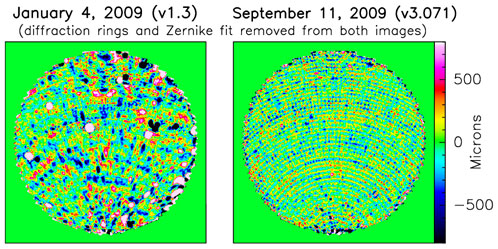
Preliminary aperture efficiency measurements at 43 GHz yield values of 55-60% at most elevations, confirming the new surface statistics. As a result, we expect the high frequency performance for the upcoming observing season to be measurably better than last season. These improvements are the result of an iterative set of holography maps, surface adjustments, and efficiency measurements.
Using high-resolution 11.7 GHz holography maps, NRAO scientists and engineers have been able to identify the individual surface panel actuators that were out of adjustment, in which direction (+/-), and by what amount. In addition, during the summer maintenance period, several defective actuators were repaired, and several of the surface panel corners were re-set manually. For this most recent map, all of the GBT’s 2,209 surface panel actuators were in operation, a credit to the diligence and hard work of the GBT technicians.
The GBT has been operating regularly at 90 GHz since fall 2007 with the MUSTANG bolometer array. Continual improvements in both the MUSTANG array and the GBT high frequency performance have improved the measured aperture efficiency at 90 GHz by more than a factor of 2 (as of May 2009), and new measurements will be made soon. In addition to the improvements in small-scale errors from the holography maps, Out-Of-Focus (OOF) holography can be used by MUSTANG, Q-Band, and Ka-Band observers to measure and remove the large-scale deformations caused by surface heating and structural deformations during daytime and evening observations. Combined with additional instrumentation now installed on the structure and the digital servo control system under development, the GBT is well on its way to achieving its 3 mm performance goals.
Student's GBT Discovery Earns White House Trip
Dave Finley
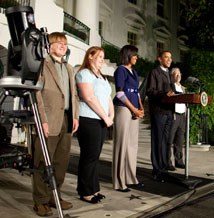
President Barack Obama and First Lady Michelle Obama host an astronomy event on the South Lawn of the White House, October 7, 2009. Participants include: Dr. John Holdren, Office of Science and Technology Policy; Caroline Moore, the youngest person to discover a supernova; and Lucas Bolyard, who recently discovered an anomalous pulsar with the GBT. (Official White House Photo by Chuck Kennedy)
A West Virginia high-school student analyzing data from the GBT has discovered a new rotating radio transient, a pulsar-like neutron star, and the feat won him a trip to the White House. Lucas Bolyard, a sophomore at South Harrison High School in Clarksburg, WV, made the discovery while participating in the Pulsar Search Collaboratory (PSC), a joint project of the NRAO and West Virginia University, funded by a grant from the National Science Foundation. His discovery was announced in September, and as a result, Bolyard was a guest of honor at the White House Star Party the evening of October 7. President Obama, in his opening remarks at the star party, introduced Bolyard, who was standing next to the podium.
Bolyard made his discovery in March, after he already had studied more than 2,000 data plots from the GBT and found nothing. "I was home on a weekend and had nothing to do, so I decided to look at some more plots from the GBT," he said. "I saw a plot with a pulse, but there was a lot of radio interference, too. The pulse almost got dismissed as interference," he added.
Nonetheless, he reported it, and it went on a list of candidates for West Virginia University astronomers Maura McLaughlin and Duncan Lorimer to re-examine, scheduling new observations of the region of sky from which the pulse came. Disappointingly, the follow-up observations showed nothing, indicating that the object was not a normal pulsar. However, the astronomers explained to Bolyard that his pulse still might have come from a rotating radio transient.
Confirmation didn't come until July. Bolyard was at the NRAO - Green Bank with fellow PSC students. The night before, the group had been observing with the GBT in the wee hours, and all were very tired. Then Lorimer showed Bolyard a new plot of his pulse, reprocessed from raw data, indicating that it is real, not interference, and that Bolyard is likely the discoverer of one of only about 30 rotating radio transients known.
Suddenly, Bolyard said, he wasn't tired anymore. "That news made me full of energy," he exclaimed.
Rotating radio transients are thought to be similar to pulsars, but instead of continuously emitting, they emit only sporadically, one burst at a time, with as much as several hours between bursts. Because of this, they are difficult to discover and observe, with the first one only discovered in 2006.
"These objects are very interesting, both by themselves and for what they tell us about neutron stars and supernovae," McLaughlin said. "We don't know what makes them different from pulsars -- why they turn on and off. If we answer that question, it's likely to tell us something new about the environments of pulsars and their emission mechanisms," she added.
The PSC, led by NRAO Education Officer Sue Ann Heatherly and Project Director Rachel Rosen, includes training for teachers and student leaders, and provides parcels of data from the GBT to student teams. The project involves teachers and students in helping astronomers analyze data from 1500 hours of observing with the GBT. The 120 terabytes of data were produced by 70,000 individual pointings of the GBT. Some 300 hours of the observing data were reserved for analysis by student teams.
Video of the President's Remarks
Video of Lucas Bolyard's Discovery
2009 Mountain State Award
Michael Holstine

The Mountain State Award is presented to Cara Rose and Bill Saxton on behalf of the NRAO by Gail Hyer, Marketing Specialist for the Pocahontas County Convention and Visitors Bureau.
The West Virginia Division of Tourism presents its Stars of the Industry Awards each year in recognition of excellence in the state's tourism industry, including the Mountain State Award, which recognizes excellence in tourism programming and impact on the state's economy or image. We are pleased to announce that the National Radio Astronomy Observatory is the 2009 Mountain State Award recipient. We want to recognize Cara Rose for her outstanding management of the Green Bank Science Center tourism programs, and Bill Saxton for his outstanding graphic design contributions to these programs.
Career Opportunities
New Postings
Research Associates (Postdoctoral Scholars): The North America ALMA Science Center (NAASC) is inviting applications for one or two Postdoctoral Scholars at its headquarters in Charlottesville, Virginia to work with the S4G (Spitzer Survey of Stellar Structure in Galaxies) team. The S4G is designed to be the ultimate legacy survey for the distribution of stellar structure in the nearby universe. For more information on the S4G, visit http://web.ipac.caltech.edu/~kartik/s4goverview.pdf
Science Writer: The National Radio Astronomy Observatory in Charlottesville, Virginia is recruiting a Science Writer. Working In collaboration with observatory scientific, technical, and media design staff, the Science Writer will research, plan, and write articles and multimedia/video scripts for web pages, exhibits, and media programs that communicate scientific and technical concepts to science-attentive public audiences (including students).
Assistant Scientist/A: The team of scientists at the Green Bank Telescope (GBT) is seeking an Assistant Scientist/A to provide full scientific support to the GBT and the NRAO. Responsibilities will include supporting observers who use the telescope as well as working on a diverse variety of projects, which may include the development and commissioning of new instrumentation on the telescope, working with the engineering staff to improve the overall telescope performance, and aiding with the data reduction pipelines needed for the GBT. The position will be filled at the assistant, associate, or scientist level, depending on experience.
Jansky Fellowships: The 2010 Jansky Fellowship provides outstanding opportunities for research in astronomy. Jansky Fellows formulate and carry out investigations within the wide framework of the Observatory. Candidates with interest in radio astronomy instrumentation, computation, and theory are encouraged to apply.
NRAO Postdoctoral Fellow: The North American ALMA Science Center (NAASC) invites applications for a Postdoctoral Fellow to work with the NAASC scientific staff. The focus will primarily be on independent research, with an emphasis on exercising ALMA end-to-end software and databases from a scientific perspective, in particular the Splatalogue spectral line database.
Scientists (NAASC): The North American ALMA Science Center (NAASC) seeks applicants with research interests in areas related to the goals of ALMA to join its User Support staff. They will provide advanced scientific and technical support to members of the North American ALMA community, and will have the opportunity to pursue a vigorous and independent research program. These positions will be filled at the assistant, associate, or scientist level, commensurate with experience.
Software Engineer II: The Software Development Division in Green Bank, WV is seeking a Software Engineer to help design, develop, implement, and support the Dynamic Scheduling System for the Green Bank Telescope. The Dynamic Scheduling System is broken into three major components: a web application built with the Django web development framework, a series of custom user interfaces built with Ext GWT, and the core scheduler implemented in the functional programming language, Haskell. The Dynamic Scheduling team uses agile software development methods and automated unit testing to provide a working system for sponsors at every step of system development.
Software Engineer III: The Software Development Division in Green Bank, WV, is seeking a Software Engineer to provide support for the scientists who use the Green Bank Telescope (GBT). Work will be directed initially toward improvements in the post-observing data analysis and reduction software as well as developing data reduction and analysis software infrastructure for existing instrumentation.
Systems Engineer: The Atacama Large Millimeter Array (ALMA) is currently seeking a Systems Engineer at its headquarters in Charlottesville, Virginia, to work as part of the System Engineering team participating in equipment acceptance, planning system requirement verifications, maintaining system sensitivity, reviewing test results and populating those results to the available budget.
 Zoom
Zoom